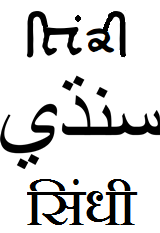Language/Sindhi/Grammar/Verbs-and-Tenses
Introduction
In this lesson, we will learn about Sindhi verbs and tenses. Verbs are a crucial part of any language and in Sindhi, they can be both complex and fascinating. At the end of this lesson, you will have a better understanding of how verbs work in Sindhi, their different forms and tenses, and how to use them in a sentence.
Verbs in Sindhi
In Sindhi, verbs are used to show an action or a state of being. They can be modified to reflect different tenses, moods, and voices. Verbs can also be used as auxiliary verbs in compound tenses or to create different forms, such as causative or reflexive verbs.
Verb Forms
In Sindhi, verbs are conjugated to reflect different grammatical aspects like tense, person, and number. There are three major forms of verbs in Sindhi:
- The root form (infinitive)
- The imperfect or present form
- The past or perfect form
The root form is also known as the infinitive form of a verb. This is the base or original form of a verb, and it usually ends in "-N" or "-WAN". For example:
| Sindhi | Pronunciation | English |
|---|---|---|
| قراڻ | qurāṇ | to read |
The imperfect or present form is used to describe actions happening in the present. This form of the verb does not indicate if the action is continuous or not. To form the imperfect tense, add the suffix "-ANDO" to the root form. For example:
| Sindhi | Pronunciation | English |
|---|---|---|
| قراڻ-اندو | qurāṇ-ando | I am reading |
The past or perfect form is used to describe actions that have already happened in the past. To form the past tense, add the suffix "-AYA" to the root form. For example:
| Sindhi | Pronunciation | English |
|---|---|---|
| قراڻ-ايا | qurāṇ-āya | I read |
Tenses
In Sindhi, there are three major tenses: present, past, and future. Each tense is used to describe an action in relation to its occurrence in time.
Present Tense
The present tense is used to describe an action that is happening at the moment or a state of being. To form the present tense, add the suffix "-ANDO" to the root form of the verb. For example:
| Sindhi | Pronunciation | English |
|---|---|---|
| ٽيڪ تائين ناپين-اندو | ṭīk tā'īn nāpīn-ando | I am checking the measurement |
Past Tense
The past tense is used to describe actions that have already happened in the past. To form the past tense, add the suffix "-AYA" to the root form of the verb. For example:
| Sindhi | Pronunciation | English |
|---|---|---|
| اکي پوڻ ٿيل آهي | akī pōṇ ṭēl āhī | he broke the bowl |
Future Tense
The future tense is used to describe an action that will happen in the future. To form the future tense, add the auxiliary verb "thio" ("will") before the verb in the root form. For example:
| Sindhi | Pronunciation | English |
|---|---|---|
| سڀني جي جوتي پوچن ٿي ٿيِن | sabhnī jī jutī pōchin ṭī thin | I will wash everyone's shoes |
Moods
In Sindhi, there are three major moods: indicative, imperative, and subjunctive. Each mood is used to communicate different levels of certainty of the action's occurrence.
Indicative Mood
The indicative mood is used to express factual information or to ask questions. This mood is also used for reporting, narrating, or describing actions. For example:
| Sindhi | Pronunciation | English |
|---|---|---|
| ٻنهنجو ڪتاب پڻ سزائي ۾ خريدندو آهن | bheṇhijō kitāb pēn szā'ī mēn kharīdandō āhun | They are buying my book in penalties. |
Imperative Mood
The imperative mood is used to give commands or make requests. To form the imperative mood, use the root form of the verb. For example:
| Sindhi | Pronunciation | English |
|---|---|---|
| انڪائو | inkā'ō! | Listen! |
Subjunctive Mood
The subjunctive mood is used to express wishes, doubts, and hypothetical situations. To form the subjunctive mood, add the suffix "-CHHO" to the root form of the verb. For example:
| Sindhi | Pronunciation | English |
|---|---|---|
| الله هٽي ڪري سدڙيه | Allāh haṭī kari sadaṛe | May Allah grant you success |
Voices
In Sindhi, there are two voices: active and passive. The active voice is the default form of a verb, where the subject is doing the action. The passive voice is used when the subject undergoes the action.
To form the passive voice, use the auxiliary verb "JOTHE" before the verb in the past tense form. For example:
| Sindhi | Pronunciation | English |
|---|---|---|
| اسان کي سيال چونڊيلو گٺو ٿا | asān kī siyāl chōndēlo ghaṭō ṭā | We were given clean water. |
Conclusion
In this lesson, we have learned about the different forms and tenses of Sindhi verbs. We have also explored the moods and voices that are used to express different levels of certainty and action. Verbs are a fundamental aspect of any language, and in Sindhi, they can be both complex and fascinating. Keep practicing and exploring new vocabulary, and soon you will feel more comfortable with Sindhi verbs and tenses. Good luck!
Other Lessons
- Nouns and Pronouns
- Basic Consonants and Vowels
- How to Use Be
- Conditional Mood
- 0 to A1 Course
- Question Formation
- Pronouns
- Plurals
- Conditional Sentences
- Passive Voice
Sources
- Past tense of ToBe - English Sindhi Grammar - SindhiTutorials
- Introduction - English Sindhi Grammar - SindhiTutorials
- Present tense of ToBe - English Sindhi Grammar - SindhiTutorials

